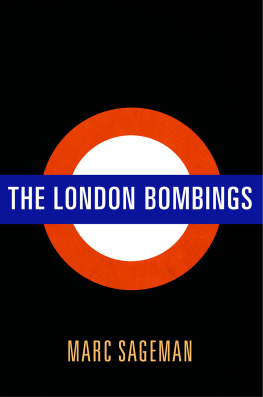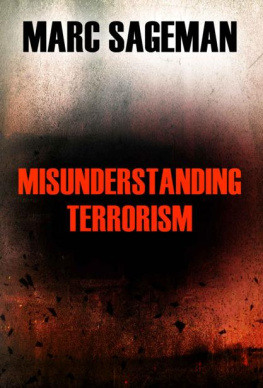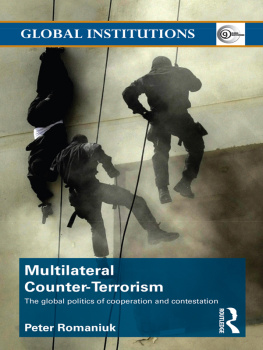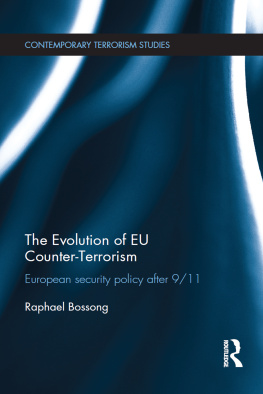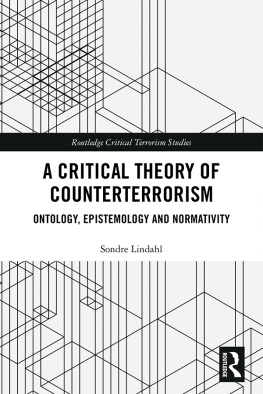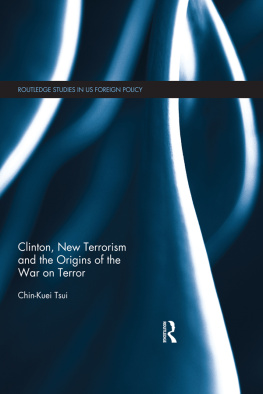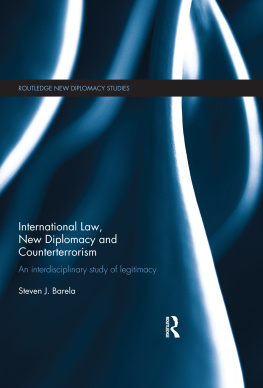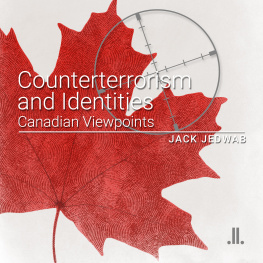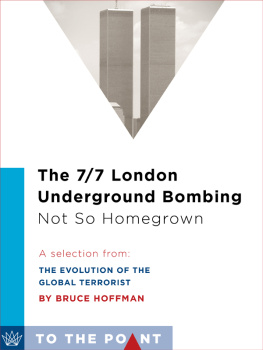Copyright 2019 Marc Sageman
All rights reserved. Except for brief quotations used for purposes of review
or scholarly citation, none of this book may be reproduced in any form by
any means without written permission from the publisher.
Published by
University of Pennsylvania Press
Philadelphia, Pennsylvania 19104-4112
www.upenn.edu/pennpress
Printed in the United States of America
on acid-free paper
1 3 5 7 9 10 8 6 4 2
Library of Congress Cataloging-in-Publication Data
Names: Sageman, Marc, author.
Title: The London bombings / Marc Sageman.
Description: 1st edition. | Philadelphia : University of Pennsylvania Press,
[2019] | Includes bibliographical references and index.
Identifiers: LCCN 2018033405 | ISBN 978-0-8122-5118-0 (hardcover)
Subjects: LCSH: London Terrorist Bombings, London, England, 2005. |
TerrorismEnglandCase studies. | TerrorismReligious aspects
Islam. | TerrorismPreventionGovernment policyGreat Britain.
Classification: LCC HV6433.G713 L6575 2019 | DDC
363.32509421/090511dc23
LC record available at https://lccn.loc.gov/2018033405
IN ABOUT FIFTY SECONDS London became the frontline of the Global War on Terror. On 7 July 2005, around 8:47 A.M., at the end of rush hour, three nearly simultaneous explosions tore apart the London Underground. At first, the trickling of information to both the London Undergrounds Network Control Center and the London Metropolitan Police Headquarters indicated mysterious fires breaking out at the same time at several different locations. At 9:14 A.M., the center ordered all trains to pull into stations and remain there. At 9:40 A.M., it ordered an evacuation of the entire network. Seven minutes later, as television showed the first blackened and bloodied victims emerging from the tunnels, an explosion in a bus in Tavistock Square confirmed that this was a terrorist operation. The British government shifted into high gear and immediately held a high-level COBRA (Cabinet Office Briefing Room A) meeting.
In the first days after the explosions, speculations were rampant but the people in London did not panic: they simply carried on. Within days, four suicide bombers were identified as the authors of this carnage, which killed fifty-two innocent people and injured seven hundred more. The explosions completely shattered British counterterrorism services assumptions about the global neojihadi
Haymans contrasting perspectives on global neojihadi terrorism or a bottom-up threat, leaderless and more extensive, spontaneously self-organized clusters of violent guys disillusioned with peaceful legitimate ways to address their grievances and outraged by Western persecution of their co-religionists at home and abroad?
These are important questions to answer. Fear grows from vagueness, confusion, and ignorance, when unconnected events are blended together and appear to magnify the threat. After the devastation of the September 11, 2001, attack on the United States, Western powers tried to counter this threat by spending trillions of dollars for national security, killing hundreds of thousands in invasions of two countries and operations in several failed states, and passing harsh antiterrorism measures at home. These measures selectively targeted Muslims, alienating a large portion of this community, and increased the threat they were meant to minimizea self-fulfilling prophecy. They also affected the rest of society, as the overestimated threat became the justification for large-scale state surveillance of all electronic communications. This overreaction violated civil rights and protection of privacy gained through centuries of political struggle. These civil rights became the essence of Western liberal democracies. Does this alleged threat justify such infringement on civil rights?
Of course, despite alarmist warnings from some scholars and journalists, These two perspectives are not just academic disputes but have real consequences in terms of strategy to counter the threat. If the threat is simply top down, the eradication of al Qaeda would eliminate the threat. On the other hand, if the threat is also bottom up in addition to being top down, the destruction of a terrorist organization abroad is not enough. Western society must prevent global neojihadi sympathizers from turning to violence. Counterterrorist measures must be empirically adapted to the actual nature of the threat but also preserve civil liberties as much as possible. The analysis of the actual nature of the global neojihadi threat to the West requires a detailed account of al Qaedas most dangerous attacks in order to understand the worst-case scenarios against the West.
A survey of global neojihadi plots or attacks in the West in the post-9/11 decade shows that there were 66 such plots or attacks, of which 16 were directly linked to al Qaeda itself. The detailed accounts of these four attacks act as a reality check on many speculations about the global neojihadi threat and point to some of the ways of countering this threat with minimal disruption to civil liberties and privacy.
Methodology
Terrorism, especially after the tragedies of the 9/11 attacks, the Madrid and London bombings, and the new wave of Islamic State attacks, has captured There is no one reliable database on terrorism. Research into this topic must resort to a process of triangulation that may answer specific questions. The method is to use multiple sources of information because any piece of data is more or less biased. Awareness of these systematic biases helps to compensate for them through comparison with other sources of data and other cases of political violence at different times and places. The ideal data collection would of course have been a series of ethnographic participant observations. However, since terrorism is a criminal activity, this form of collection would require an observer to become an accomplice by not alerting the authorities of an impending crime. Instead, I had to rely on a variety of sources, each with its own strengths and weaknesses.
To understand the nature of terrorism requires data that is both very detailed and reliable. Given the amount of nonsense written on this subject, one cannot escape going back to primary sources, free of expert or journalist interpretation. So far, the richest kind of these primary sources is legal evidence presented at terrorist trials. I have therefore collected legal material for this project: discovery material for these trials, transcripts of the proceedings, notes about the proceedings from such trials, and judgments justifying sentences. In the English-speaking world, criminal jurisprudence has developed a tradition of fairness based on an adversarial system of confrontation, whereby the prosecution case can be challenged by the defense. Initial hysterical speculations can be refuted through the systematic sifting of evidence in court. From this conflicting evidence, one can better approximate what really happened.
Prosecution documents and government claims are only claims: they need to be corroborated, which is the reason that trials test them with challenges from defendants. Most of the time, the claims of the government present the most incriminating scenario about defendants. Without hearing the defendants side of the story, they cannot be viewed as reliable. They are only the first salvo in the long battle of evidence. Many of these claims do not withstand scrutiny at trial when confronted with defense evidence. This is why it is so important to collect the actual transcripts to check on competing claims.

